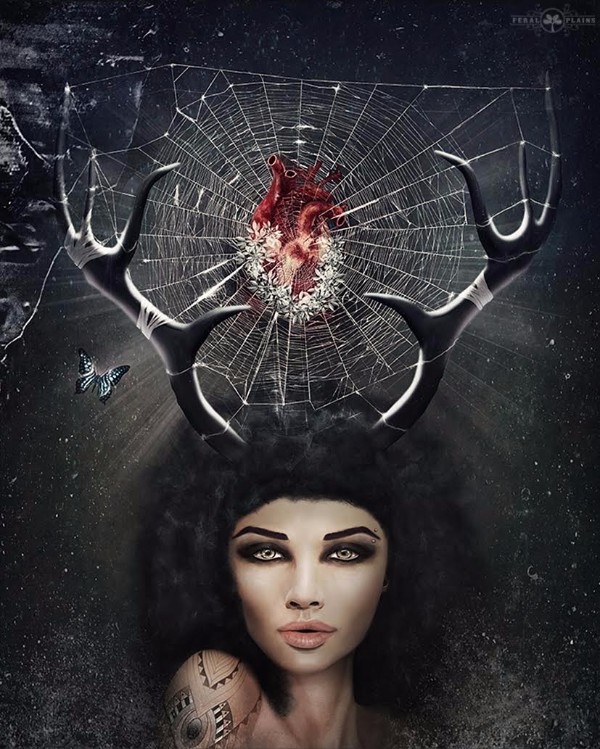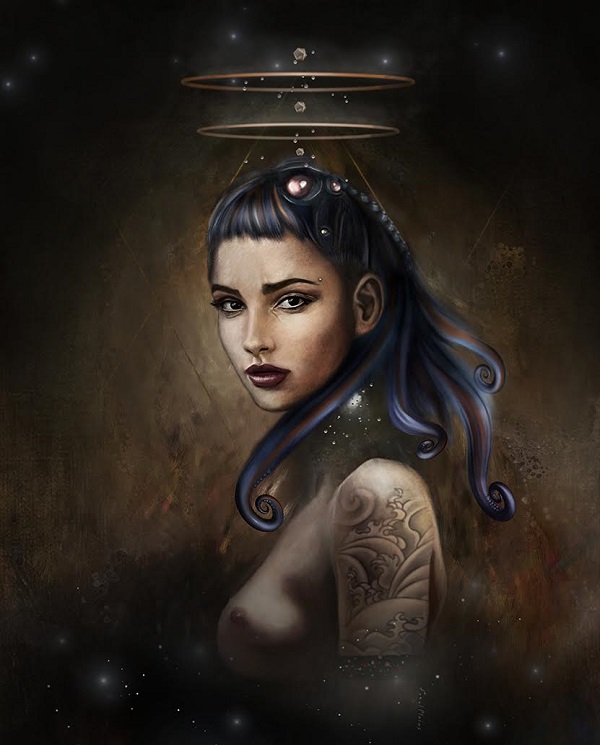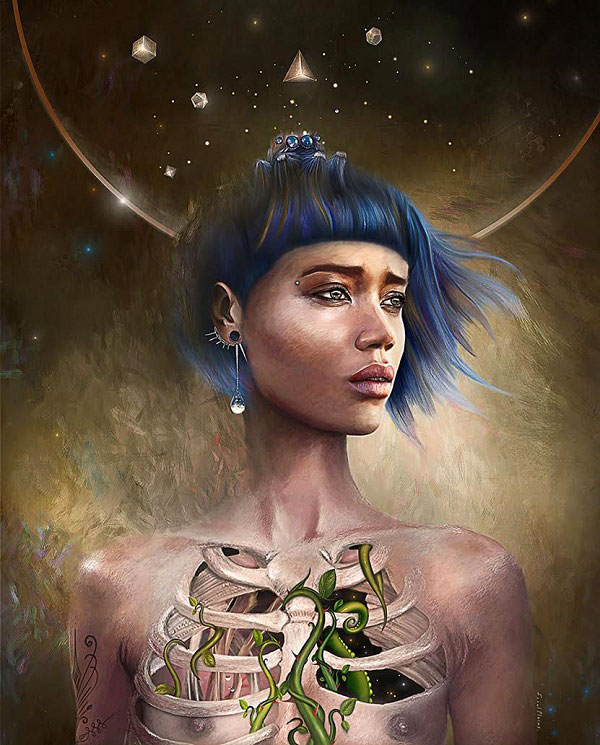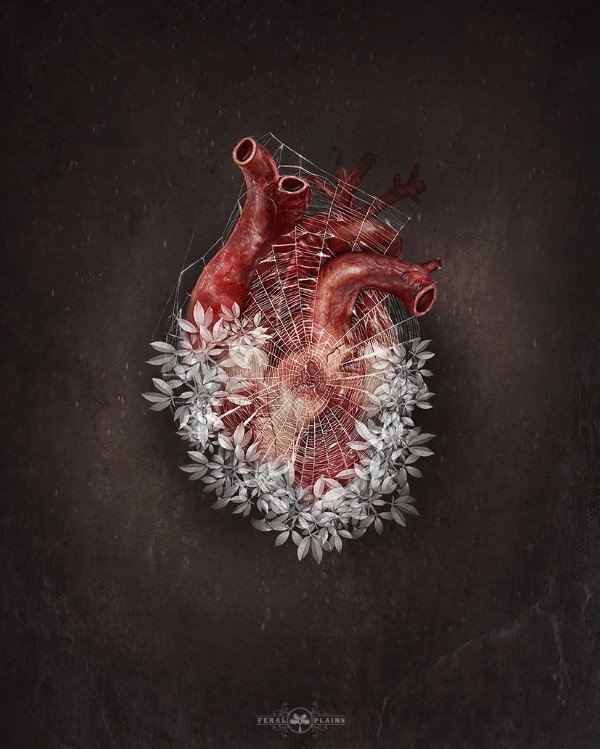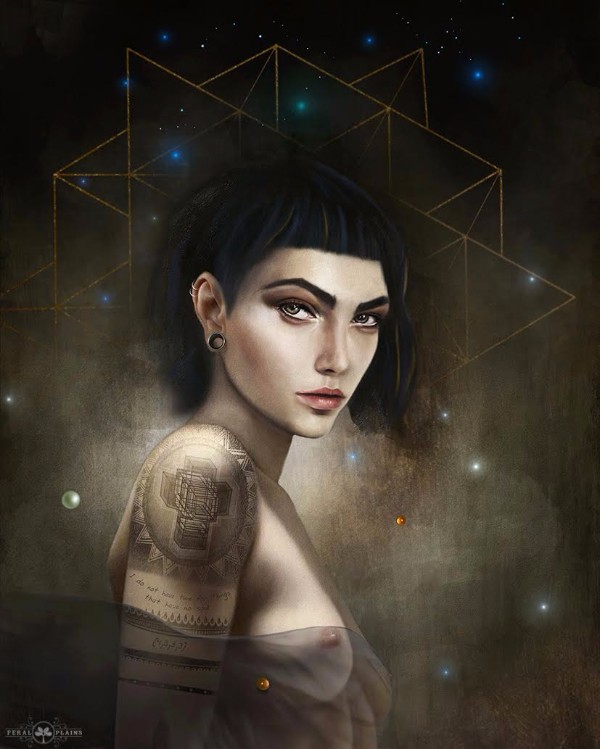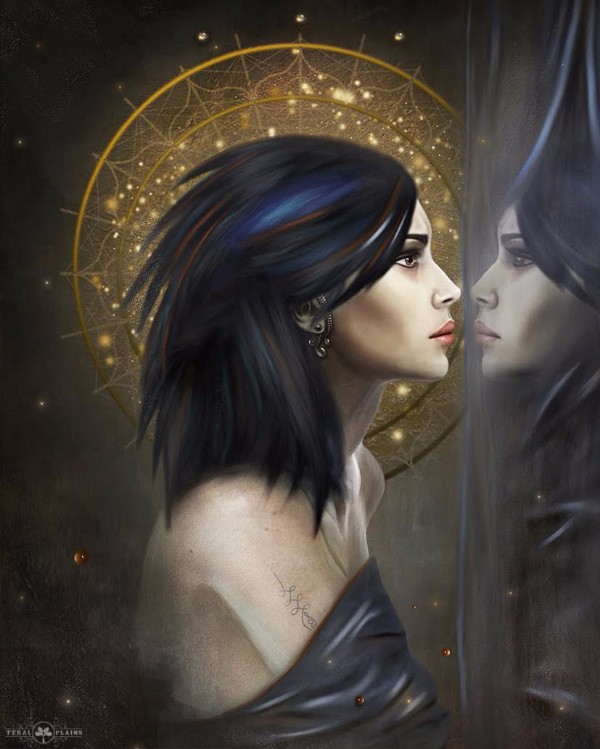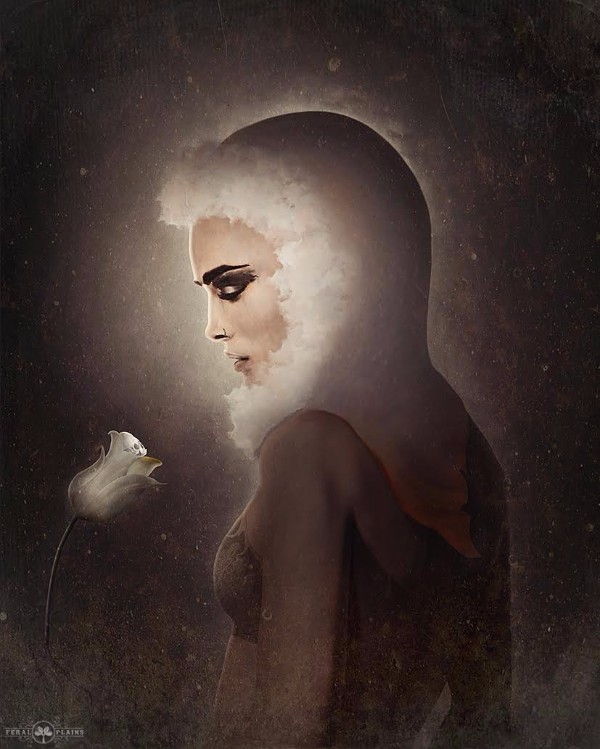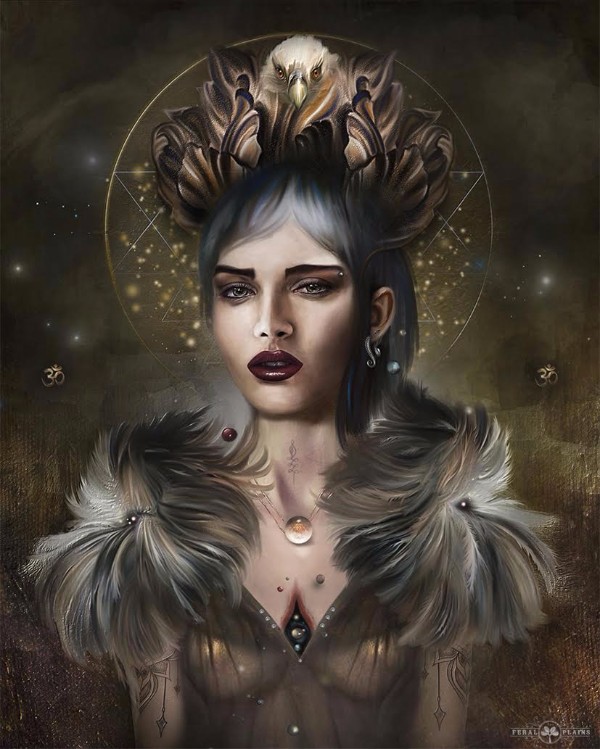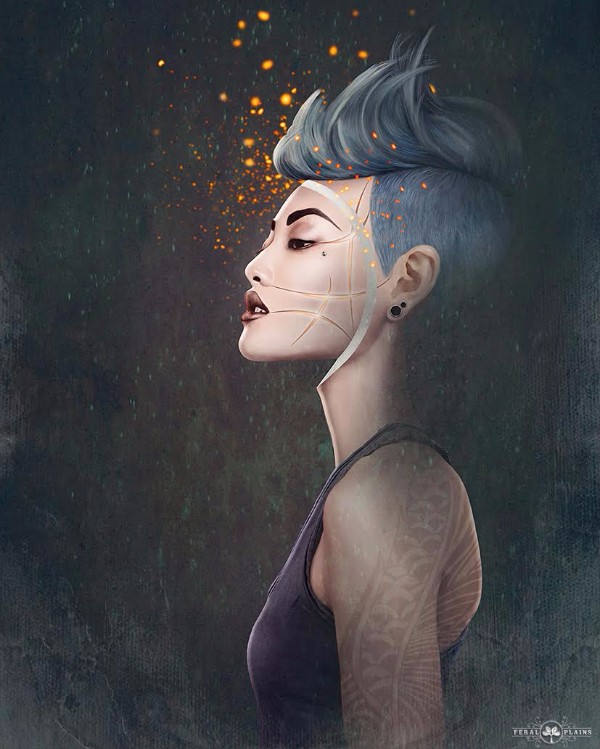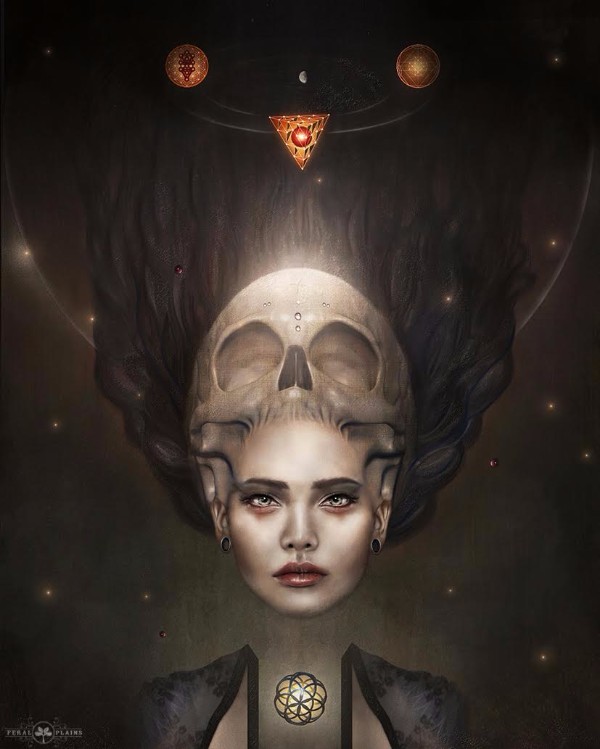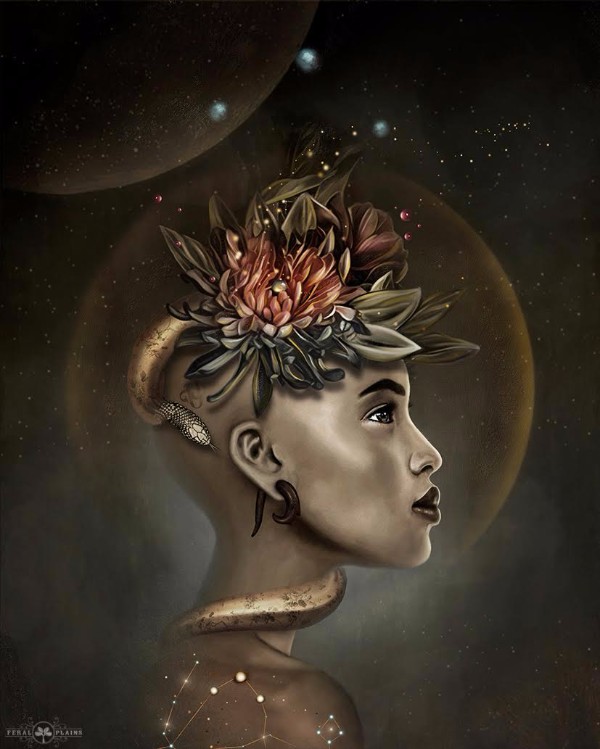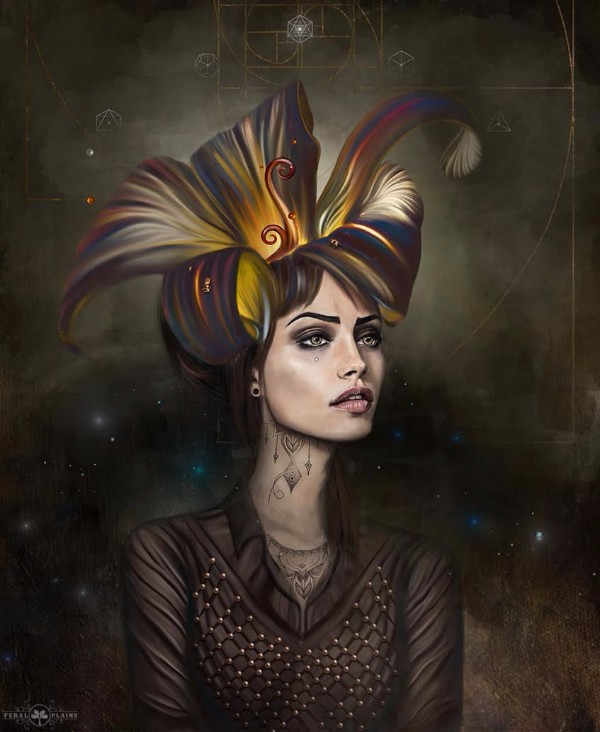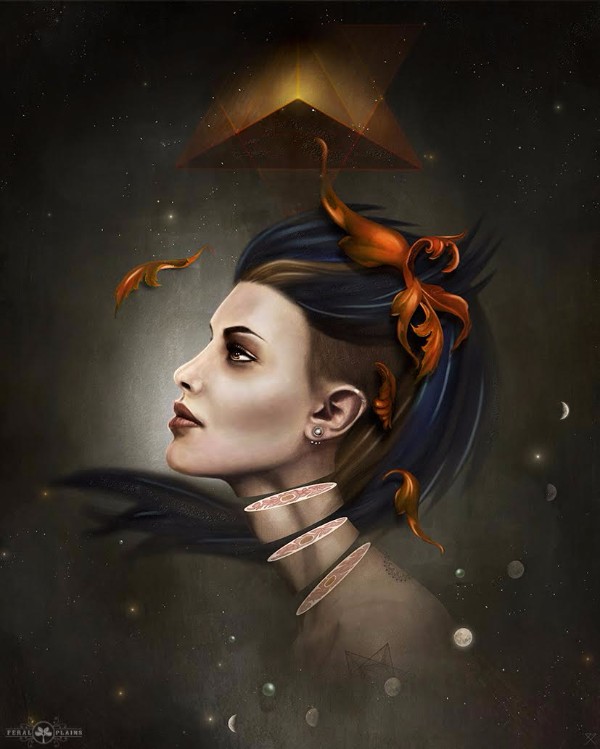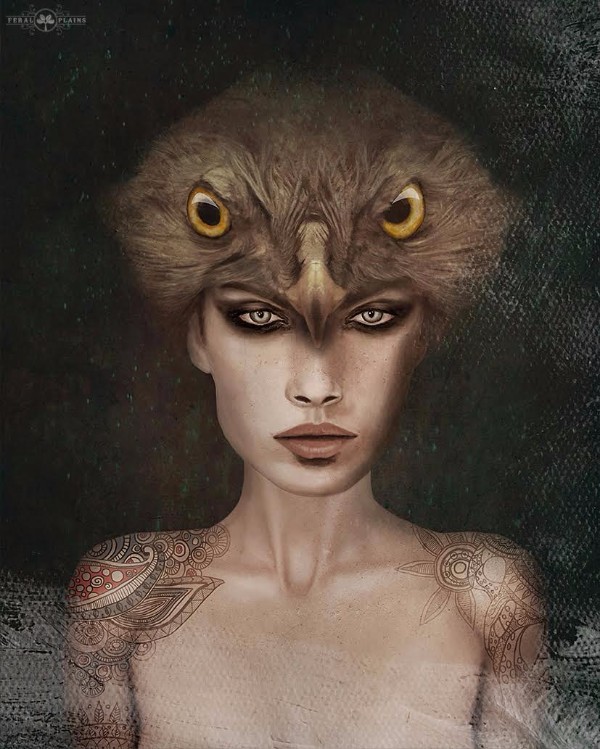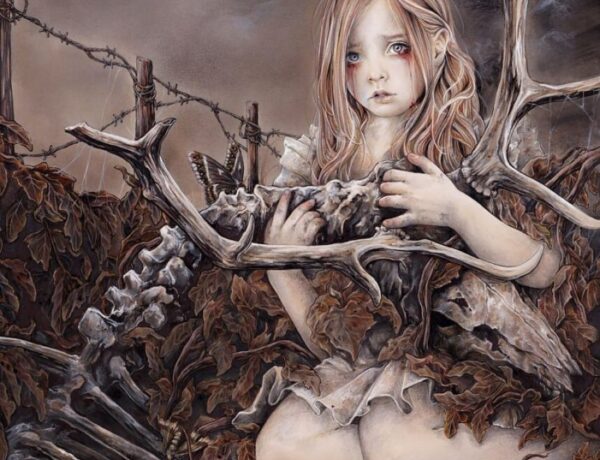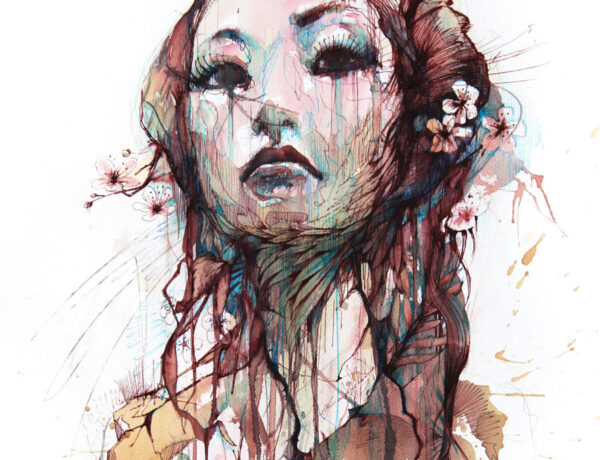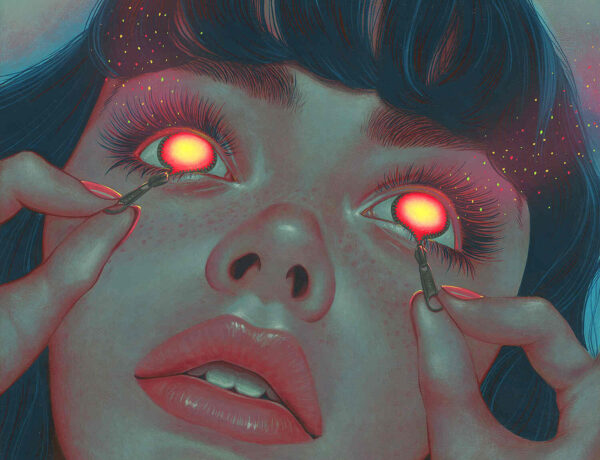 Digital artists Feral Plains delve deeply into the intricacies and symbolism of life. Nothing is placed on the page without meaning and a pure representational objective. These balanced and deeply emotionally charged pieces make their work easily identifiable in the art world. There needs to be a deep understanding of the transience of life, both explored and considered, for it to be so beautifully expressed in their work. The dark and striking females often seen in their pieces are haunting and powerful. There is much to be seen in the narrative, and Feral Plains is always inviting you to explore the meaning hidden behind the pieces. It is no coincidence that Beim and Marijn find inspiration from strong women with defining stories, not unlike their own.
Digital artists Feral Plains delve deeply into the intricacies and symbolism of life. Nothing is placed on the page without meaning and a pure representational objective. These balanced and deeply emotionally charged pieces make their work easily identifiable in the art world. There needs to be a deep understanding of the transience of life, both explored and considered, for it to be so beautifully expressed in their work. The dark and striking females often seen in their pieces are haunting and powerful. There is much to be seen in the narrative, and Feral Plains is always inviting you to explore the meaning hidden behind the pieces. It is no coincidence that Beim and Marijn find inspiration from strong women with defining stories, not unlike their own.
The mythology behind the pieces is what attracted me to their work, and their ability to express the emotion using three-dimensional modeling. Feral Plain’s digital painting style is deeply thoughtful, bold women, both behind and on the page. I recently interviewed Marijn Achten and Beim D’hondt. They shared with us some stories about their process and how these beautifully interpreted characters are created.
With an upcoming show at Kunzthiuz opening May 5, 2017, this year could prove one of their busiest yet!
“We conjure environments,
Where the lost species roam free,
Existence is in suspense,
Dreams become reality
Lives are dreamed in these domains,
Streaming from our pulsing veins
Beauty, viciously unchained,
Flowing through the Feral Plains”
Follow Feral Plains: Web | Facebook | Instagram | Tumblr
Thank you for spending time with us to discuss your work. Can you tell me a little about yourselves and your backgrounds?
I was born in India, grew up in Bocholt and Biem was born in Bruges Belgium. We currently reside in Koksijde (or Coxyde as we’re only 7 km from the French border). In our minds, we already live in a warmer place with a slightly bluer sea but for now Koksijde certainly has its charms, barren winters, silence and a quiet place to work. It’s an interesting place to live, most people come here on holidays. Usually it’s so very quiet, there’s hardly any human sound pollution, you can hear nothing but the sound of high tide coming in, the beating of the wind and the cry of seagulls. And then not two days later it is holidays and people (and friends) show up everywhere, the whole atmosphere changes, there’s suddenly this strange sense of urgency, of things needing to be done in a certain amount of time, in a certain place and with certain rules in mind. It’s a very strange push and pull feeling, for them it’s holidays, for us it’s an ‘all-hands-on-deck’ time. It has made us very aware of our environment and how to be meaningful artists.
The most important thing for us to learn was no more fear. Focus on yourself, how you feel, step by step and enjoy every step you take.
There is no need to feel intimidated, to think ‘we can’t’ or it’s going be hard.. enjoy it all, the hard, the difficult, the pleasure of accomplishment, just be mindful and enjoy the long road.
M: We met at the university where Biem studied for her Master’s in International Politics while I was working for my Master in Visual Arts. Biem had set out to prove to the world that all you need is focus and an eager interest in your subject to excel expectations. I thought this was a very interesting idea because everybody is always searching between what is more important, talent or diligent hard work. Perhaps hard work is too narrow and it should be eager interest and focus, it will make you pick apart the result that sparks your imagination and that’s how we learn.
B :The willingness to spend hours and hours on the same drawing, to make it better, to make it perfect, to finally let go-it’s never going to be perfect- and then to start all over again. I think I sometimes creep people out by staring at them, at how the light hits their eyes, how it catches their cheekbones, how a certain feature can grab you and you stand there looking weird at them in the middle of a conversation.
Can you tell us about the symbolism you use in the pieces, and why you choose to use it in your work?
In Zaria Forman’s talk she says, “Behavioral psychology tells us that we take action and make decisions based on our emotions above all else. And studies have shown that art impacts our emotions more effectively than a scary news report.”
We’ve both been trying to find the purpose of becoming an artist, I think it’s humane to search for a purpose that fulfils a roll. I always find the most comfort in realizing that we are souls living a human experience. And it’s something we want to put into the work as a constant reminder that no matter what happens, joy or sadness, because every good, full life also experiences confusion, sadness and suffering and in those moments. We hope we can provide an image that makes you feel less alone, that makes you remember there are many connections beyond this human experience.
Where do you find your inspirations? Can you share a little about your technique without giving too much away!
Inspiration to us starts from taking the first step into creating a positive environment for ourselves. It’s such a difficult thing to do, to let go of expectations, of people, places… but we think this step is mandatory to really be able to create consistently. In that inspiring TED video where Elizabeth Gilbert talks about the process of creativity and how inspiration can be like Dobby the House Elf that sneaks up on you when he finds you working and puts the magic into it, we completely loved that idea. To us it feels more as if the universe opens up and sends us all the inspiration we need to make a new painting every week. But Elizabeth Gilberts idea inflamed this trust inside of us that it will be all right.
Once the environment is working for us, we think the things that make us feel inspired are thoughts, music, books, and people around us that we feel comfortable with without wanting to hide under a stone, as you once said to us.
B: We both have different approaches when it comes to creating an artwork and even those approaches are different depending on the mood. Sometimes I just have this very strong longing to paint a face, and I start painting and Dobby drops by and fills it with magic. Other times I have to create a whole mood before I can start, it starts with an emotion, it can be something I’ve been feeling strongly about, or often I have to research to put a name to it, or to enhance it. Then comes the music, I love all kinds of music but sometimes I can feel that focus to paint beginning to build up, like when you’re surfing and you have to catch that wave or it will be gone forever. I need a song I can put on repeat, all the way from beginning to end. Then I can ride that wave, and start feeding the beast.
M: Our progression is often a push and pull thing. I struggle a lot with not holding the story in my head while Biem keeps pushing to work more abstractly. To me it’s a constant exercise in letting go. But more technical, Biem starts painting a face and I usually start working on the first story, which doesn’t always communicate with the face or the intended emotion, then we go back and forth until we’ve found a story and an emotion that works for us both.
How did you make a start in the digital art world and what led you to this?
“In contradiction often lies the truth.” said Mapplethorpe to Patti Smith. We come from an analogue education. On graduation day we stepped into a different world that was fully digitalized and we felt very suspicious of it, the products didn’t respect that old craftsmanship, the know-how of building a beautiful camera was a bit lost, as well as smelling paint and the thickness of paint on canvas. For a long time we struggled with it, we even resented it a little bit. But as our workload started growing, working digital became so much quicker, you can use small rooms because you don’t need an atelier, it’s not as environmentally taxing, compositions are altered with the click of a button. And the idea of trying to find a hack of the old way made it much more playful and very much in line with the people we are and the ideas we have.
M: When we started Feral Plains, we stepped out of the capitalist dream to find the values we think are more important to us.
B: We’re living with a lot less now, we don’t let society drive our expectations (as much as we can), and we’re very mindful of the road we’re taking. It’s made us grow so much stronger at a much younger age. Many people here don’t question their values or realize their life’s dream until they stop working. We’re very grateful to be able to do that now.
M: We’ve embraced the digital era but it does steer us in a certain direction, as we believe you need to allow a certain flow, we sometimes wonder if we would want to get away from the realism in our paintings. When I was younger I was very fond of Marlene Dumas where hands can be green, bodies purple, and I always like it when candy doesn’t carry the color it should have to mimic a certain taste. But in our early 2015 work we used a lot of Zbrush and sculpted everything realistic after models. Now we paint faster through Corel Painter and Photoshop and we have a lot more freedom. And so everything always feels like a contradiction.
B: You conquer one thing and you long for the other.
Can you speak a little bit about the process and the difficulties you encounter being digital artists?
We feel very Zen about the whole process. We’re slowly taking our steps, we don’t need to rush but we work diligently on the body of work. Every week we show something new and in May, we plan to open our store for the second time. To do it this slow is fun because you create this momentum to work towards. In the early years we thought it was enough to just create the art itself but that is only the necessary step, next up is finishing (varnishing, mounting, framing..), photographing your product, promoting and selling it. We both do enjoy the change in pace this brings. We don’t really know about the difficulties on being a digital artist.
David Seidman gave a beautiful solo show at Arch Enemy Arts. Tom Bagshaw and Ray Caesar are doing great and are more than wanted.
To be honest we really don’t feel much difficulty. We’ve often heard people saying that major galleries are very suspicious about digital work but slowly finding our way we do feel very embraced between all sorts of galleries and traditional artists. We do believe that when the work is good and it fits in with the subject then it holds up perfectly between traditional works.
Last year we participated in Exhibit 02 by Kunzthuiz, the work fitted in nicely between all professional traditional artists and they were sold out so fast, for which we still feel grateful.
We do understand that some people panic with the idea of not having an original but so far, we’ve only made originals from which no editions are created. In the near future, we do plan to make additions and we’ll differentiate by making the original larger, hand embellished and framed.
